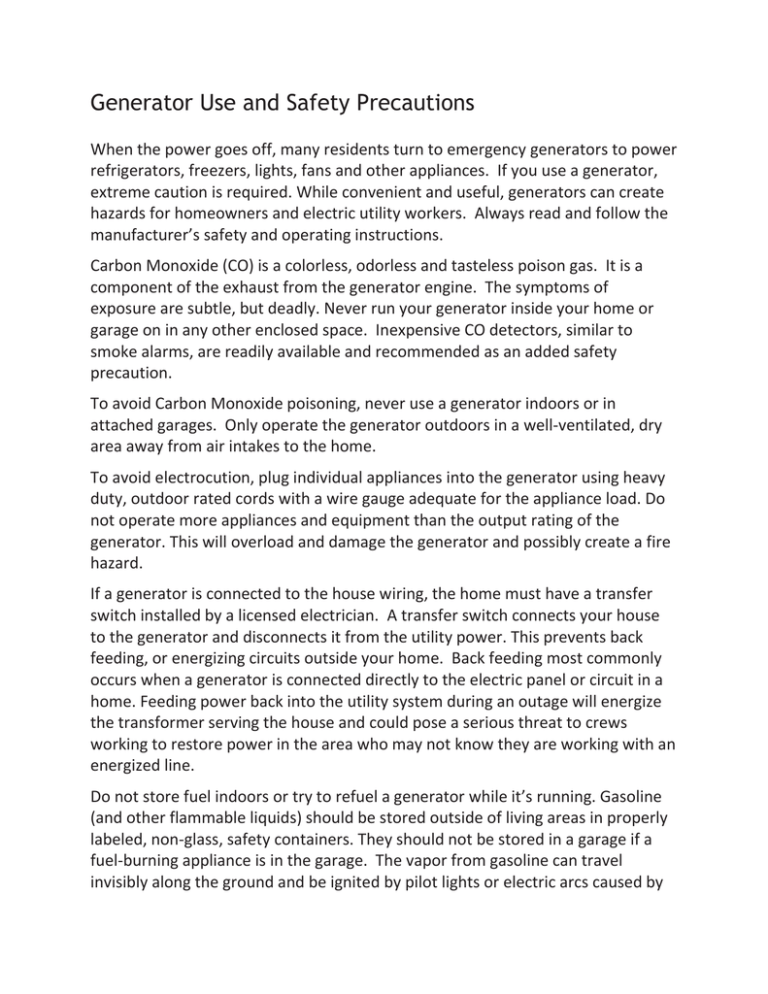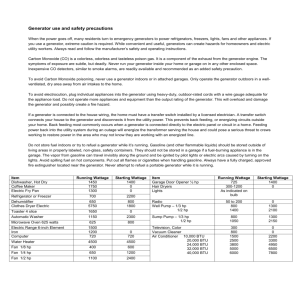Generator Use and Safety Precautions
advertisement

Generator Use and Safety Precautions When the power goes off, many residents turn to emergency generators to power refrigerators, freezers, lights, fans and other appliances. If you use a generator, extreme caution is required. While convenient and useful, generators can create hazards for homeowners and electric utility workers. Always read and follow the manufacturer’s safety and operating instructions. Carbon Monoxide (CO) is a colorless, odorless and tasteless poison gas. It is a component of the exhaust from the generator engine. The symptoms of exposure are subtle, but deadly. Never run your generator inside your home or garage on in any other enclosed space. Inexpensive CO detectors, similar to smoke alarms, are readily available and recommended as an added safety precaution. To avoid Carbon Monoxide poisoning, never use a generator indoors or in attached garages. Only operate the generator outdoors in a well-ventilated, dry area away from air intakes to the home. To avoid electrocution, plug individual appliances into the generator using heavy duty, outdoor rated cords with a wire gauge adequate for the appliance load. Do not operate more appliances and equipment than the output rating of the generator. This will overload and damage the generator and possibly create a fire hazard. If a generator is connected to the house wiring, the home must have a transfer switch installed by a licensed electrician. A transfer switch connects your house to the generator and disconnects it from the utility power. This prevents back feeding, or energizing circuits outside your home. Back feeding most commonly occurs when a generator is connected directly to the electric panel or circuit in a home. Feeding power back into the utility system during an outage will energize the transformer serving the house and could pose a serious threat to crews working to restore power in the area who may not know they are working with an energized line. Do not store fuel indoors or try to refuel a generator while it’s running. Gasoline (and other flammable liquids) should be stored outside of living areas in properly labeled, non-glass, safety containers. They should not be stored in a garage if a fuel-burning appliance is in the garage. The vapor from gasoline can travel invisibly along the ground and be ignited by pilot lights or electric arcs caused by turning on the lights. Avoid spilling fuel on hot components. Put out all flames or cigarettes when handling gasoline. Always have a fully charged, approved fire extinguisher located near the generator. Never attempt to refuel a portable generator while it is running. Item Dishwasher, Hot Dry Coffee Maker Electric Fry Pan Refrigerator or Freezer Dehumidifier Clothes Dryer Electric Toaster 4 slice Automatic Washer Microwave Oven 625 watts Electric Range 6‐inch Element Iron Computer Water Heater Fan 1/8 hp Fan 1/4 hp Fan 1/2 hp Item Garage Door Opener ½ hp Hair Dryers Lights Running Wattage 1450 1750 1300 700 650 5750 1650 1150 Starting Wattage 1400 0 0 2200 800 1800 0 2300 625 800 1500 1200 720 4500 400 650 1100 0 720 4500 600 1200 2400 Running Wattage Starting Wattage 725 1400 300‐1200 As indicated on bulb 0 Radio 50 to 200 0 Well Pump – 1/3 hp 1/2 hp 800-1400 1300-2100 Sump Pump – 1/3 hp 1/2 hp 800-1050 1300-2150 300 800 0 0 1500 2500 3800 5000 6000 2200 3300 4950 6500 7800 Television, Color Vacuum Cleaner Air Conditioner 10,000 BTU 20,000 BTU 24,000 BTU 32,000 BTU 40,000 BTU



